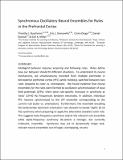Synchronous Oscillatory Neural Ensembles for Rules in the Prefrontal Cortex
Author(s)
Buschman, Timothy J.; Denovellis, Eric L.; Diogo, Cinira; Bullock, Daniel; Miller, Earl K.; Miller, Earl K.; Buschman, Timothy J.; ... Show more Show less
DownloadCognitive Flexibility with supplemental.pdf (3.151Mb)
PUBLISHER_CC
Publisher with Creative Commons License
Creative Commons Attribution
Terms of use
Metadata
Show full item recordAbstract
Intelligent behavior requires acquiring and following rules. Rules define how our behavior should fit different situations. To understand its neural mechanisms, we simultaneously recorded from multiple electrodes in dorsolateral prefrontal cortex (PFC) while monkeys switched between two rules (respond to color versus orientation). We found evidence that oscillatory synchronization of local field potentials (LFPs) formed neural ensembles representing the rules: there were rule-specific increases in synchrony at “beta” (19–40 Hz) frequencies between electrodes. In addition, individual PFC neurons synchronized to the LFP ensemble corresponding to the current rule (color versus orientation). Furthermore, the ensemble encoding the behaviorally dominant orientation rule showed increased “alpha” (6–16 Hz) synchrony when preparing to apply the alternative (weaker) color rule. This suggests that beta-frequency synchrony selects the relevant rule ensemble, while alpha-frequency synchrony deselects a stronger, but currently irrelevant, ensemble. Synchrony may act to dynamically shape task-relevant neural ensembles out of larger, overlapping circuits.
Date issued
2012-11Department
Massachusetts Institute of Technology. Department of Brain and Cognitive Sciences; McGovern Institute for Brain Research at MIT; Picower Institute for Learning and MemoryJournal
Neuron
Publisher
Elsevier
Citation
Buschman, Timothy J., Eric L. Denovellis, Cinira Diogo, Daniel Bullock, and Earl K. Miller. “Synchronous Oscillatory Neural Ensembles for Rules in the Prefrontal Cortex.” Neuron 76, no. 4 (November 2012): 838–846.
Version: Author's final manuscript
ISSN
08966273
1097-4199